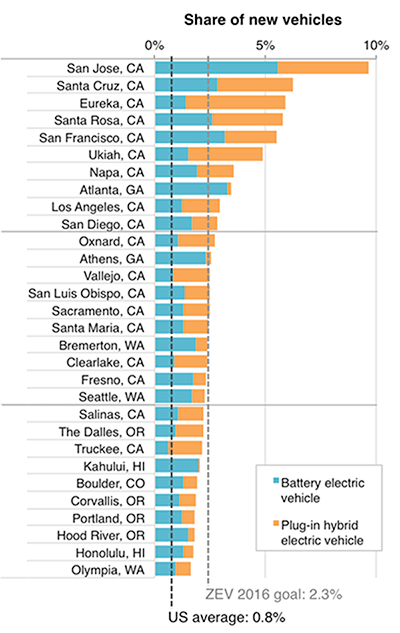Blog
The EV future—already here, just not evenly distributed yet?
It is an exciting time in the electric vehicle market, with sales rising globally and the number of models multiplying. The US remains the world leader in total EV sales, while Norway is way out in front on sales share—about 14% of new vehicles purchased there are EVs. Automakers launched seventeen new models in the US from 2012 to 2014, and more are on the way for 2015. Nissan, Tesla, and now utilities (e.g., in Kansas City and perhaps California) are building out the charging network. (See here for how the charging network is filling out in your neighborhood.) Consumer incentives proliferate and expand, as recently seen in Massachusetts (although there are setbacks too, as in Georgia).
Amid all the global activity, we’ve also been interested in what patterns are emerging on the local level. We’ve been looking at data from U.S. cities, and here’s one very noticeable finding: distribution of EV sales is very uneven across the top 30. The chart below shows the top 30 metropolitan areas in the US, based on the share of new light-duty vehicles that are plug-in electric (including plug-in hybrid electric and fully battery electric vehicles). California cities dominate the list, with 18 of top 30 US cities. San Jose is far out in front, with about 1 in 10 new vehicles being plug-ins. After California, Washington, Oregon, Georgia, and Hawaii come next with multiple high-EV-uptake cites. The top 10 cities have from 4 to 13 times the electric vehicle uptake of the national US average.

Thirty metropolitan areas with highest electric vehicle shares in the US in 2014 (Data source: IHS Automotive)
This raises the question: What factors are influencing this uneven distribution? As my colleague Sarah Chambliss recently wrote, many factors contribute to faster electric vehicle market growth in some areas. These include the California Zero Emission Vehicle (ZEV) program, state financial incentives, non-financial policy actions, charging infrastructure, and local demographics. Among the top 30 cities, 18 are in California and 22 are in ZEV states. These cities, and the rest in the top 30, tend to have significant fiscal and non-fiscal incentives, outreach programs, and/or extensive charging infrastructure to help promote electric vehicle purchasing. And automakers’ decisions with respect to when and where to launch, dealer incentives and training, and the marketing campaigns for new models are critical parts of the equation—but these automaker-specific actions are not very well characterized yet.
Beyond just exploring the data, we’ve begun to wonder about the wider implications looking forward. Among other things, there are implications for major regulations. The US EPA and NHTSA projected that the US vehicle market would only need to be 2% plug-in electric vehicles in 2025 to achieve compliance with the CAFE and CO2 regulations, with the regulatory fuel economy target for 2025 being 54.5 mpg. If EV deployment outpaces the agencies’ estimates, then less advanced gasoline efficiency technology would be needed for federal compliance. California’s Zero Emission Vehicle program requires that plug-in electric shares reach about 2% in 2016, 10% in 2021, and 15% in 2025. As the chart shows, many California cities are well ahead of this pace already. These results bode well for ZEV compliance. But the auto companies will have to spread out their electric vehicle deployment to cover the rest of the ZEV-adopting states. With all the new plug-in models, and new incentives that were adopted mid-2014 in Massachusetts and Maryland (and potentially Oregon in 2015?), the uptake might continue to outpace expectations.
Our ongoing study of electric vehicles in US cities has been focused on the 25 most-populous metro areas. The data above strongly suggest that there are many lessons to be learned from the smaller cities too. For example, of only 6 of the 25 largest metro areas in the U.S. (San Francisco, Atlanta, Los Angeles, San Diego, Seattle, Portland) made the top 30 in electric vehicle market share.
As William Gibson said, “the future is already here—it’s just not evenly distributed yet.” We could very well be seeing the future of transportation in the leading California, Oregon, and Washington cities. If we continue to learn from and embrace what’s working (and discard what’s not), the progress toward an electric fleet could continue – more quickly and more evenly.
